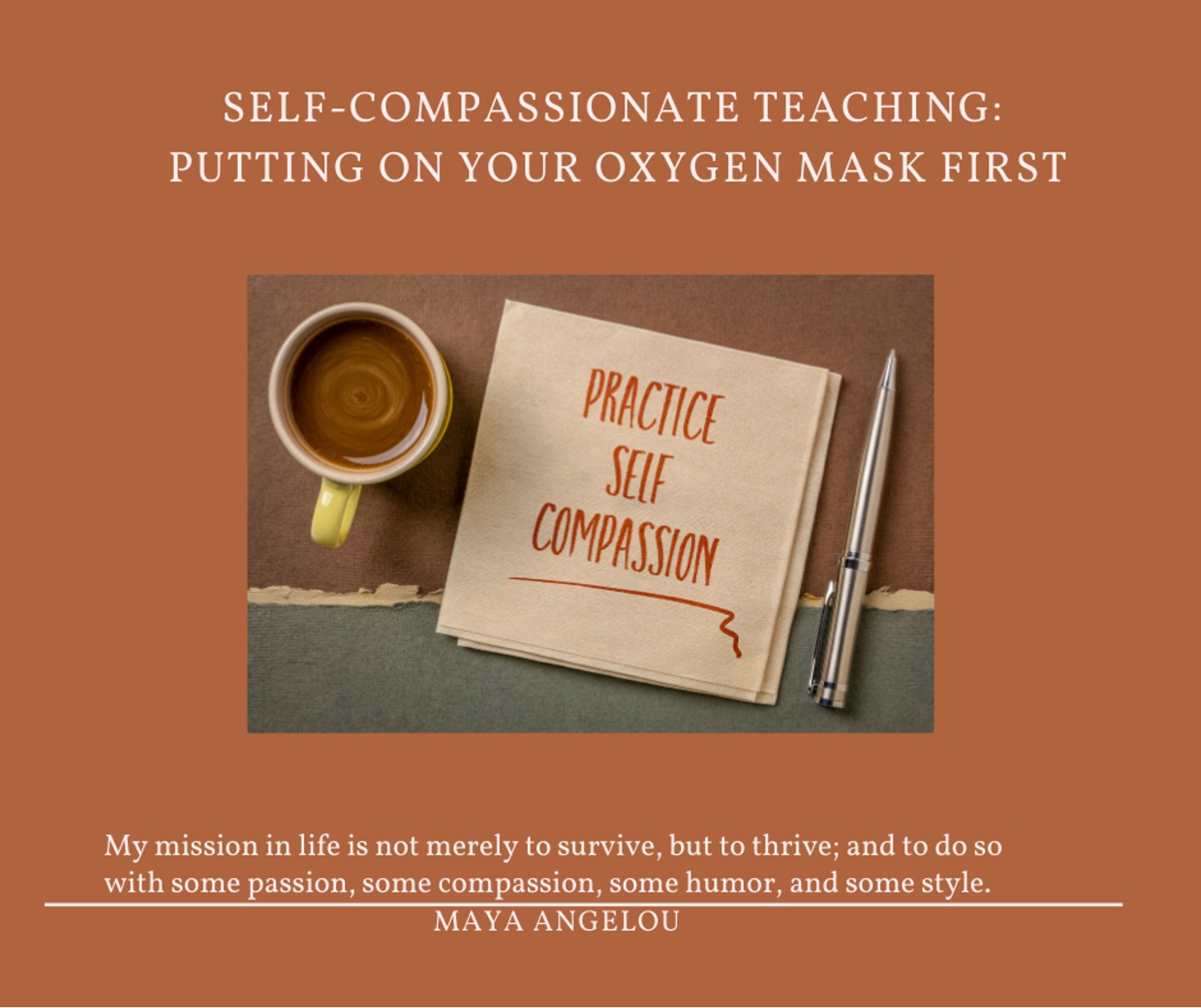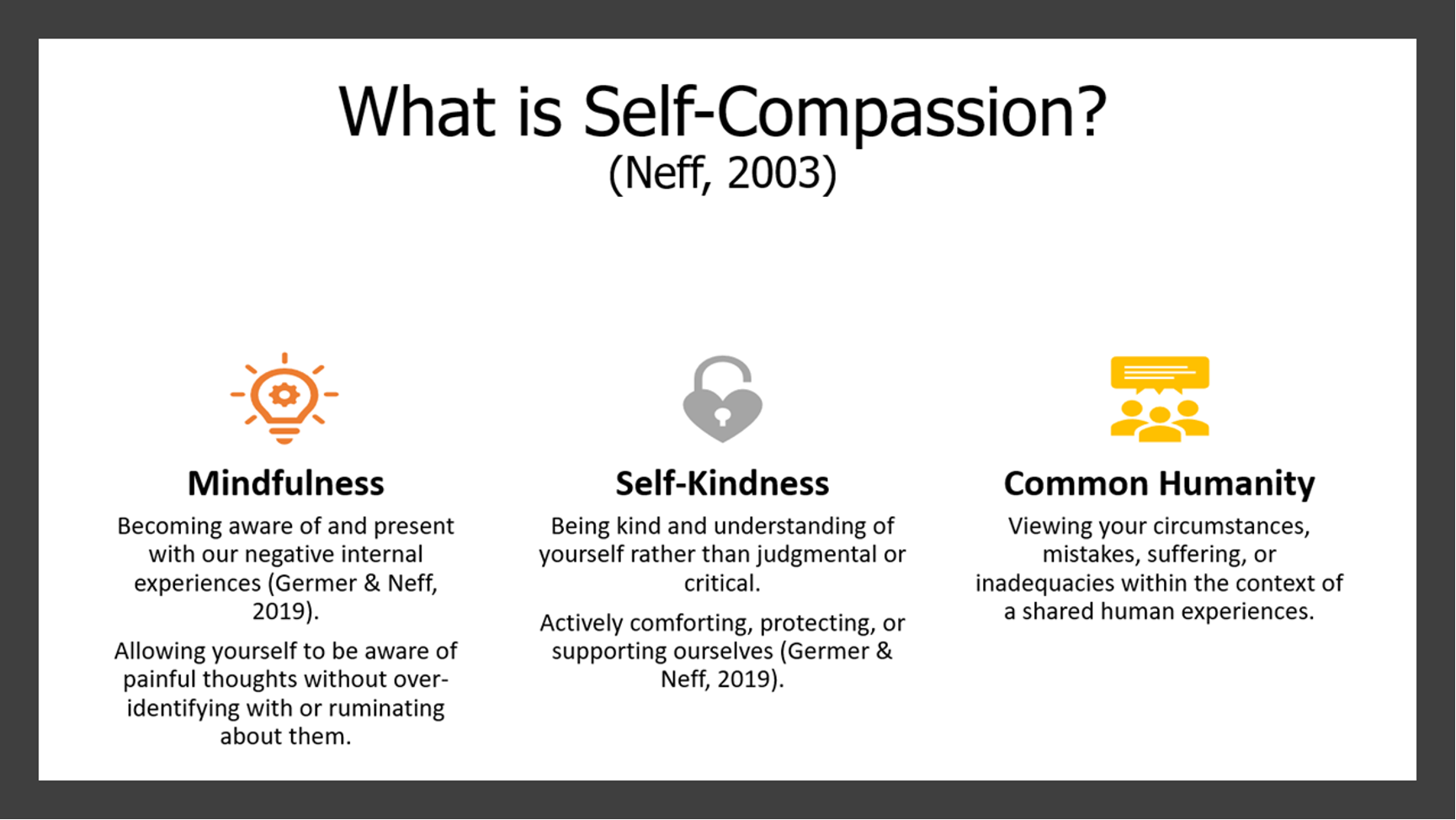Self-compassionate Teaching: Putting on your Oxygen Mask First
| by Julaine Fowlin, Becca Sandhu and Samantha York |
Print Version |
|
Cite this guide: Fowlin, J., Sandhu, B. & York, S. (2021). Self-compassionate Teaching: Putting on your Oxygen Mask First. Vanderbilt University Center for Teaching. Retrieved [todaysdate] from https://cft.vanderbilt.edu/self-compassionate-teaching/. |
 |
Recently I had the awesome opportunity to collaborate with Becca Sandhu and Samantha York from the Student Care Network to facilitate a workshop on self-compassionate teaching. The genesis of the workshop was the awareness that due to the pandemic faculty and students have had to do so much transitioning for teaching and learning to occur.
Since the spring of 2020, we have seen repeated calls for faculty to be more empathetic to online learners. I join with Antone Goyak in saying
“Our learners are not in need of our criticisms or quick judgments. They do not need our assumptions about the unknown details of their lives. They do not need our labeling of them as a certain type of student. What they desperately need and desire is our identifying with them in their circumstances. They need our empathy. [Compassion]”
However, I step back and posit that in order for faculty to have this compassion and empathy for students they must first have it for themselves. They must first be willing to practice self-kindness instead of self-judgement or self-criticism, and this is where self-compassion fits in. Though the pandemic highlighted the need for self-compassion it is important during a pandemic and also in more normal times. Faculty have always felt responsible for making things work in their teaching environments and they can often be hard on themselves when things don’t work as well. At times the “either-or” mentality permeates our minds and we struggle with the dissonance of being good in one area (say, classroom teaching) and struggling in another (online teaching). At the workshop, we invited participants to take a moment and embrace the “both-and”. For example, I can be an instructional designer who coaches individual faculty well and someone who encounters resistance when planning a workshop for a large group. You can be a faculty who does great research, publishes well, and teaches effectively in a face-to-face setting and someone who struggles to put your classes online. That is ok.
What is Self-compassion?
In the workshop, we adopted Neff’s (2003), definition of self-compassion as having 3 elements:
- Mindfulness vs. Over-identification
- Self Kindness vs. Self-Judgement
- Common Humanity vs. Isolation
See Figure 1. Created by Becca for a description of each.
I like how Black (2018), describes self-compassion as becoming our own first responders and providing kindness upon arrival. This leads me to dispel some of the myths about self-compassion. Self-compassion is not denial, it is acknowledging our mistakes, challenges, failures, however, instead of addressing them with self-judgement, we do so with the kindness of constructive feedback for the future.
Becca gave a great example of what this might look like when a parent comforts a child who has failed an exam. For example, a parent who provides a harsh and critical response might say something like:
“I’m ashamed of you,” or “You’re stupid,” or “You’ll never amount to anything.”
Rather than being motivating, that child will likely experience shame, a loss of self-confidence, or may give up trying altogether.
On the other hand, a parent who provides a compassionate response might say something like:
“Ah man, what a bummer. You must be upset, give me a hug. It happens to all of us. We need to get these grades up because I know you really want to get into a good college. I believe in you. What can I do to support you?”
It’s important to notice that the compassionate response still recognizes the failure (mindfulness), recognizes and makes space for the associated emotions (mindfulness), recognizes that things like this happen to everyone (common humanity), provides encouragement that can help build self-confidence (self-kindness), and also recognizes that there may be hard work and effort required to change the situation.
Additionally, such a response is likely going to be far more motivating for that child to make a change, will preserve their self-confidence, and help them feel supported in the process. Unfortunately, it’s all too common for us to speak to ourselves like the parent who provided a harsh and critical response. Self-compassion is about motivating ourselves with encouragement rather than criticism.
How can we get there?
Samantha gave a great analogy, that is we should view self-compassion as preventative vitamins rather than pain killers. That is we should develop a habit of self-compassion and make it part of our daily practice so it comes easier during the challenging times when we really need it. Becca led us through a great exercise called a self-compassion break. You can also experience this as a guided meditation from Kristin Neff on InsightTimer. Kristin also has some other guided meditations related to self-compassion on InsightTimer. These guided meditations are just one way to practice self-compassion. There is no right or wrong way, it is about what works for you in bringing awareness to how you are feeling, and what is most soothing to you in those moments. Additionally, creating self reminders that, though the details may be unique to you, the feelings surrounding them are not (common humanity).
B efore reading further I invite you to PAUSE and give some thought to small ways you could practice self-compassion in your life. Samantha recommended selecting one area – mindfulness, self-kindness, or common humanity – where you would like to build a practice. You might even see this as an opportunity to be compassionate with yourself in goal-setting and assess and adjust your goals to make sure you are not overextending yourself too much. Choose one domain where you feel you would benefit and look at ways to build in daily habits that reflect that value. We were very deliberate in the workshop not to jump from a focus on self to a focus on teaching and I recommend as you read this article you do the same. Let what I have shared so far infuse in you before moving on.
efore reading further I invite you to PAUSE and give some thought to small ways you could practice self-compassion in your life. Samantha recommended selecting one area – mindfulness, self-kindness, or common humanity – where you would like to build a practice. You might even see this as an opportunity to be compassionate with yourself in goal-setting and assess and adjust your goals to make sure you are not overextending yourself too much. Choose one domain where you feel you would benefit and look at ways to build in daily habits that reflect that value. We were very deliberate in the workshop not to jump from a focus on self to a focus on teaching and I recommend as you read this article you do the same. Let what I have shared so far infuse in you before moving on.
What does self-compassion have to do with teaching?
Teachers are an integral part of the teaching and learning experience. Self-compassion allows us to be ‘self-full’ so we can extend the same kindness to our students and be true to ourselves. We can view ourselves like a car if there is no gas (self-empty) the car will not drive or perform effectively. Self-compassion allows us to operate from a place of responding to ourselves and others versus reacting. Therefore self-compassion benefits us and those around us. As I shift the attention to teaching I want us to consider always thinking about yourself first in the moment so that you can be fully equipped to handle students’ needs.
- Therefore the first tip is always be kind to yourself
- As we think about operating from a place of responding versus reacting think about what strategies can help us to respond versus react to our students. One way is to assess students’ needs before the course starts. Consider using Brightspace Survey or Google Forms.
- Check-in with students throughout the course using mid-semester feedback and other formative evaluation strategies.
- Use Course Design to proactively show you care and facilitate ease in navigating your course.
- Consider how motivational theory and situating learning can proactively enhance student learning experiences.
- Set healthy boundaries and communicate these boundaries with students; being aware of suffering does not mean you are responsible for addressing the suffering.
Using Reflection Questions
Reflection questions are one way to bring self-compassion to the forefront of our lives. The table below has questions that allow us to focus on ourselves and our students—recognizing that we often need to check in with ourselves first before responding to students’ needs. For example, during the pandemic, many students are struggling; before responding to students’ suffering, it’s ok to ask ourselves how we feel about our own suffering and how we feel about responding to students’ sufferings. We also need to be mindful that a response may not require us to fulfill the need ourselves; sometimes, it is as simple as just having a willingness to see the need so we can refer students to available Student Care Network Resources. Likewise, sometimes we may need external help ( see 2nd page of PDF) to meet our own needs.
Self Focus and Student Focus Questions to Process
Neff’s three Elements of Self-Compassion
| Self-compassion Element | Self Focus | Student Focus |
|---|---|---|
| Mindfulness vs. Over-identification | What am I feeling right now? How can I give my emotions room to breathe without over-exaggerating or over-identifying? | How are my students feeling right now? What activities or strategies can I incorporate to allow me to be more aware of how students are feeling? |
| Self-Kindness vs. Self-Judgement | What do I need in this moment? How will I respond to meet my identified need? What steps can I take to respond to this need vs. react? Am I capable of meeting my own need, or do I need external help? external help | What do my students need in this moment? How will I respond to meet the identified need? What steps can I take to respond to this need vs. react? Am I capable or willing to meet the need myself, or do I need to utilize available university resources? utilize available university resources |
| Common Humanity vs. Isolation | How can I recognize the common humanity in this process and remind myself that these experiences and feelings are not unique to me? | How can I connect with the needs of my students? How can I deal with situations that are far removed from my own experience? |
CFT and Vanderbilt University Resources
- Student Care Network and Faculty/Staff Resources
- Weekly Wellbeing Practices opened to students, faculty, and staff
- CFT Blog Post: Trauma-Informed Teaching During COVID-19
- CFT Guide: Keeping Stress from Evolving into Distress: A Guide on Managing Student Stress through Course Design
- CFT Guide: Teaching in Times of Crisis
- CFT Blog Post: What Can Faculty Do about Students’ Classroom-Based Anxieties? More Than You Think
- CFT Online Course Development Resource: Assessing Student Needs in Your Online Course
- Includes Sample Information Sheet (Word)
- National Center for Faculty Development and Diversity (NCFDD)
- Through Vanderbilt University’s institutional membership, all faculty, staff, graduate students, and postdoctoral scholars have access to the National Center for Faculty Development & Diversity (NCFDD), which provides professional development and training and mentoring. These resources offer concrete guidance that could increase your productivity and your sense of well-being. Learn How to Activate Your Membership
Additional Readings and Resources
- How Self-Compassion Can Help Prevent Teacher Burnout, Berkley’s Greater Good Article
- Be Kinder to Yourself, Harvard Business Review Article
- Beating Pandemic Burnout, Inside Higher Ed Advice
- The Headspace Guide to Meditation and Mindfulness: How Mindfulness Can Change Your Life in Ten Minutes a Day
- Four Ways Teachers Can Show they Care Berkley’s Greater Good Article.
- Humanizing Online Learning
- Dr. Kristin Neff’s Self-compassion website
- Stanford’s Center for Compassion and Altruism Research and Education
References
Black, Angela. (2018, May 17). Academic Life: What’s Mindfulness and Compassion Got To Do With It? [Webinar]. National Center for Faculty Development and Diversity. https://www.facultydiversity.org/webinars/mindfulness18
Germer, C., & Neff, K. (2019). Teaching the mindful self-compassion program: A guide for professionals. Guilford Publications.
Goyak, A. (2021, January 25). Our Online Learners Need More Empathy and Less Criticism. Faculty Focus. https://www.facultyfocus.com/articles/online-education/online-assessment-grading-and-feedback/our-online-learners-need-more-empathy-and-less-criticism/
Neff, K. D. (2003). Self-compassion: An alternative conceptualization of a healthy attitude toward oneself. Self and Identity, 2(2), 85-101.

This teaching guide is licensed under a Creative Commons Attribution-NonCommercial 4.0 International License.
.
.
.
.
.
